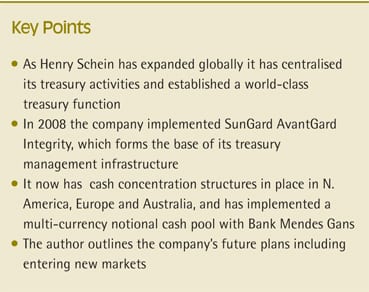by Ferdinand G. Jahnel, V.P., Treasurer, Henry Schein, Inc.
Henry Schein has experienced phenomenal growth since listing on NASDAQ in 1995, with revenues growing from $616m in 1995 to $8.5bn in 2011, the result of increased market share through internal growth and strategic acquisitions, greater product and service diversification, and major international expansion. To support this growth, our treasury function has evolved enormously over this period. Having now put in place a sophisticated cash, treasury and risk management infrastructure, our aim has been to leverage it further to maximise possible operational and financial efficiencies, and to deliver value to the organisation. As we expand internationally global cash management and FX risk have become more significant priorities. In this article, we outline how leveraging a global, multi-currency notional cash pool has enabled us not simply to optimise liquidity, but also to hedge our FX risk more effectively.
Treasury journey
Five years ago, with a far smaller business, and less exposure to international markets, our treasury decision-making and execution was not yet fully centralised, with treasury’s operational activities relating mainly to North America. At that time we did not have a treasury management system (TMS) in place. We relied on an external consulting resource to manage our European cash and the resulting FX exposures.
Since then, we have centralised our treasury activities, and recruited the skills and experience that we required to create a world-class treasury function. We now have 15 team members located primarily at our headquarters in Melville, N.Y. The team takes responsibility for cash management, financing, investments, capital structure, bank relationships, insurance and risk management, including foreign exchange (FX).

In 2008, we implemented SunGard AvantGard Integrity, which forms the basis of our core treasury management infrastructure. We use online dealing platforms for money market and FX transactions to permit straight-through processing and transparency in decision making. We connect with our banking partners through SWIFTNet of which we have become a corporate member.
In addition to putting in place an efficient treasury organisation, we needed to implement cash and risk management structures that would meet our evolving cash and risk management needs. As we have expanded internationally, our cash management requirements have become more complex, at both regional and global levels. On an in-country level we have cash concentration structures in place in North America, Europe and Australia. In addition, in 2010, we implemented a multi-currency notional cash pool with Bank Mendes Gans (BMG), a fully-owned subsidiary of Dutch-based ING, with a view to including all our operations across our global geographic footprint. We started with North America and key countries in Europe, but have since increased the number of participating entities substantially over time, so that the cash pool now almost completely covers all countries and entities that are permitted. Each business unit still has operational bank accounts with its local bank, but surplus balances are transferred to the cash pool with BMG, or deficits funded notionally, as required.[[[PAGE]]]
Leveraging a multi-currency notional cash pool
These milestones have all been important elements in creating and delivering an efficient FX hedging strategy. Although we seek the best price on FX deals by receiving competitive real-time quotes from five or six banks via an online trading platform, we wanted to reduce our total number of contracts and the cost of hedging. The concept is that we use the balances on participating accounts in the cash pool to create a natural hedge for our FX liabilities. We have found a variety of benefits to this approach (figure 1). When putting in place FX hedges, these need to be matched with the value date of the exposure. However, when using the notional cash pool, we can bring in the relevant account balance into the cash pool, so when the exposure is revalued, it is offset exactly. There are no liquidity, settlement or counterparty risks incurred. Leveraging a notional cash pool to hedge our FX risk has therefore enabled us to reduce the resources required for FX hedging considerably, cut transaction fees and FX spreads.

Building on success
Although we are very satisfied with the progress we have made in FX hedging so far, we are always finding ways to refine our policies and processes, particularly as the company continues to grow internationally, both organically and through mergers & acquisitions (M&A). For example, in May 2012 we announced the successful acquisition of AUV Veterinary Services B.V., the leading distributor serving animal health practitioners in the Netherlands and Belgium. A priority is therefore to integrate the new business into our FX and cash management structures, which is particularly challenging as formerly, AUV had very different arrangements in place.
Now that we have a robust and versatile structure in place, we can spend more time working on funding arrangements for M&A, in which we work closely with the internal tax department. We are also working on how to manage our cash, treasury and risk management requirements as we enter new markets. We are particularly interested in the Asian emerging markets, and we have already established dental distribution operations in Hong Kong and China. Although these activities are currently relatively small, they provide a platform for future growth, and a precedent for additional markets in Asia.
In summary, our ability to leverage a global, multi-currency notional cash pool has enabled us to optimise liquidity and hedge our FX risk more effectively and efficiently.







